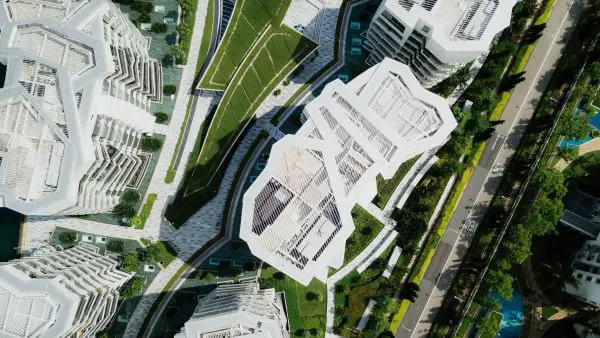Edenica: a case study for the circular economy in the built environment
Posted on: 1 August, 2024

The Edenica project is more than just another modern looking development in the heart of London – it could represent the future of construction in the built environment.
At first glance, the designs and visual mockup of 100 Fetter Lane, more commonly referred to as Edenica, may resemble those of any other modern development in the City of London.
Designed by Fletcher Priest Architects, this new 12-storey development contains elements of biophilia in its appearance, with its facades and terraces home to greenery and maximising natural lighting. It’s also targeting a BREEAM Outstanding rating, alongside WiredScore, SmartScore and WELL certifications.
Learn more: Understanding green building certifications: why should you get one?
However, what’s most fascinating about Edenica isn’t necessarily its design – it’s what will happen to it when it’s disassembled.
Material banks – a new way of viewing our infrastructure
Traditionally in the building lifecycle, when a property or structure reaches the end of its operational phase, it’s simply demolished. Much of its components and materials will be consigned to landfills, with a minimal amount being recycled.
Despite the promise of new alternatives, like retrofitting and adaptive reuse, cases like the Marble Arch Marks and Spencer store on Oxford Street, London, show that demolition is often still the preferred option when a building has seemingly run its course.
However, the Edenica development is intended to showcase another option – designing buildings to act as material banks. It’s the first project of its kind in London, with the plan for it to act as a repository of materials that can be reused for future projects. In other words, when it comes to decommissioning the building, it’s designed to be disassembled easily, and for its materials to be utilised in other buildings and structures. To make this a reality, circularity has influenced everything about Edenica, from its actual design to the selection of materials being used in its construction.
Learn more: Material banks, explained: could they be the path to a circular future?
Keeping track of materials can make material banks a reality
Ankit Singh is Director of Sustainability at Waterman Building Services Ltd, part of the Waterman Group. Waterman have been involved in the development of Edenica, and have used it as a pilot for another concept in the circular economy – material passports.
Just as people today use passports that, along with documenting where they’ve travelled, list information like their date of birth and origin, material passports are designed to track materials, components and products in the built environment. This information is stored in a centralised database.
Material passports can work in tandem with material banks to reduce the amount of waste resulting from construction projects. Having access to an accurate record of where a material has come from and its composition can help identify opportunities for recycling. It can also help suppliers and manufacturers embrace circularity and sustainability, by encouraging them to produce materials and components that align with this philosophy.
As Ankit told us in a recent conversation on the BE Sustainable podcast:
“Edenica is one of the few projects in the City of London to actually trial material passports. The reason we looked at this concept is because London is very keen to reduce carbon. It’s from this conversation, and our desire to implement circular thinking, that material passports were discussed as a useful way to track these materials.”
“Essentially, the building frame, the raised access floor and the concrete for the façade, were actually selected to trial out if we were able to identify where the material has come from, what its performance levels are, and how we can monitor it going forward.”
The challenges of achieving circularity in the built environment
One of the biggest issues holding back the mainstream adoption of both material banks and material passports is a lack of standardisation. As Ankit told us: “When we started this project, there wasn’t much guidance in terms of material passports.”
Waterman themselves are currently working on a protocol for how material passports can be produced and reported on in the UK, but for the meantime, the lack of standardisation, not just between suppliers, but on an international scale, will present a challenge for anyone looking to implement these concepts.
The biggest issue of all, however, could be the attitudes of the sector. The built environment has, in the past, struggled to collaborate and embrace change. Implementing models like material passports and achieving circularity requires stakeholders, functions and organisations throughout the entire building lifecycle to take responsibility and embrace innovation.
Could buildings of the future follow Edenica’s example?
Edenica isn’t the only development that has adopted the material bank model, but its position in London, with involvement from several significant stakeholders in the sector, could signify the beginning of a sea change in development practices. There’s no doubt that its performance will be watched closely, but while it will take years to see the fruits of its labour, the sector doesn’t have enough time to wait before adopting models like this.
With the 2050 net zero target fast approaching, the built environment is under increasing pressure to reduce its sizeable contribution to both carbon emissions and land fill waste.
The Edenica development, however, remains a source of optimism. As Maxwell Shand, Co-founder of YardNine, a property development company involved in the project, commented:
“I believe Waterman’s Material Passports initiative will quickly become widely adopted as ‘best-practice’ for responsible development.”
Sustainability isn’t a passing trend – it’s here to stay and is constantly evolving. If you want to inspire and action change in your career, UCEM’s MSc Innovation in Sustainable Built Environments will give you the skills you need, both now and in the future.
Find out more: MSc Innovation in Sustainable Built Environments – University College of Estate Management





